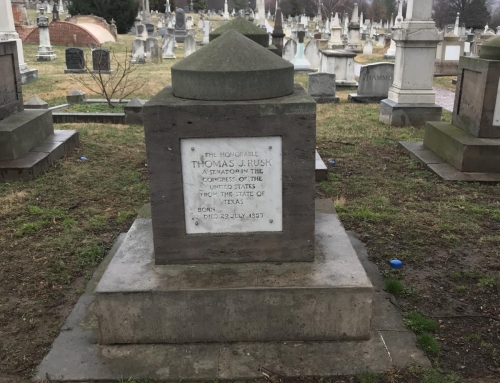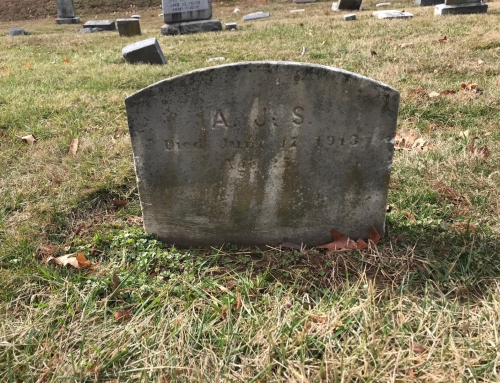Over the course of the next few weeks, Congressional Cemetery will be sharing information about green burials and the funeral industry’s role in the sustainability movement. The first section, Part One, serves as an introduction to the topic.
Each year in the United States, 22,500 traditional cemeteries put the following into the ground:
- 827,060 gallons of embalming fluid
- 30-plus million board feet of hardwoods
- 90,272 tons of steel
- 1,636,000 tons of reinforced concrete
- 14,000 tons of steel
- 2,7000 tons of copper and bronze
Furthermore, a typical ten-acre American cemetery has enough casket wood to make forty houses, at least nine hundred tons of steel from caskets and casket hardware, twenty thousand tons of vault concrete, and enough embalming fluid to fill a small swimming pool. Since Congressional Cemetery is composed of roughly 35 acres, take those numbers and multiple them by 3.5 to understand approximately how much wood, steel, concrete, and embalming fluid is under the ground at Congressional Cemetery.
Conventional burials, which typically include: preserving a corpse through the practice of embalming, public viewing at a funeral home, transporting a corpse to a funeral home and a cemetery, and a casket burial, have numerous lasting negative effects on the environment. For instance, greenhouse gas emissions are produced by the use, manufacture, and transportation of embalming fluids, caskets, grave liners, and the frequent mowing of cemetery lawns. Metal caskets are a major concern in acidic soils due to the threat of leaching heavy metals, specifically iron, copper, lead, and zinc, into the surrounding ground and water sources. Wood caskets often consist of preservatives, varnishes, and sealants, many of which contain arsenic and other harmful chemicals. Vaults made out of concrete, fiberglass, and asphalt, all of which are pollutants, also off-gas and leach pollutants. Furthermore, the harvesting, manufacturing, processing, and transportation of casket and vault materials also contribute to high energy use.
The process of cremation, which is becoming increasingly popular in the United States, is considered to be not as harmful for the environment when compared to conventional burials. Cremated remains, or “cremains,” are bones that have been processed into tiny particles after cremation. The process of cremation removes organic matter and bacteria from the bone, thus stopping the body’s natural decomposition process. Ultimately, bones become stabilized and do not change when the cremains are scattered.
Cremations release greenhouse gasses and other toxic chemicals into the environment. For instance, each cremation releases between .8 and 5.9 grams of mercury per cremated body. This totals to between 1,000 to 7,800 pounds of mercury released annually in the U.S. 75% of this mercury goes into the air and the remaining 25% of the mercury settles into the ground and water sources. Cremated remains consist of elements essential for plant and microbial life, including: nitrogen, phosphorous, potassium, calcium, magnesium, sulfur, and sodium. However, there is no probiotic potential for any of the elements in cremains due to high levels of sodium and a high alkaline pH of 11.8. Additionally, the average cremation uses 28 gallons of fuel to burn a single body, which emits about 540 pounds of carbon dioxide into the atmosphere. A person could drive about 4,800 miles on the same amount of energy that it takes to cremate one person. Essentially, the chemical properties of cremains can minimize or prevent the natural nutrients found in bones from becoming active in the environment because ashes in their natural form are toxic to plants. Despite the environmental consequences of cremations, the Green Burial Council still recognizes cremation as a green burial option.
In the U.S., we have a growing consciousness about the importance of living sustainably and making environmentally friendly decisions. But what about after life?
Do not fear—green burials are here! While there is a limited number of green cemeteries in the United States, we are proud that Congressional Cemetery is an active green cemetery.
But what exactly is a green cemetery? A green cemetery is a cemetery that allows green burials. The main objective of a green cemetery is to create an environment that appears and functions like a natural environment. Green burials have many characteristics including: disposing of a corpse without using formaldehyde-based embalming; foregoing the use of environmentally harmful concrete burial vaults; utilizing a locally sourced and biodegradable shroud (a cloth used to wrap around a corpse), casket or urn; minimizing heavy and large equipment for burial and landscaping; reducing the use of gas-powered equipment, such as lawn mowers, fertilizers, pesticides, and herbicides; encouraging native plant growth; using natural means of weed and pest control, such as the use of goats or burning; and maintaining a gravesite that is marked with an engraved fieldstone or no stone at all. Some green cemeteries let native plants grow freely in the field to reduce the amount of fossil fuels required for mowing and maintaining the lawn. Regardless, with green burials, people tend to make efforts to plant native species that capture carbon and beautify the surrounding landscape. It is important to note that each individual cemetery decides where they are on the spectrum of “green,” and no two “green” cemeteries are alike.
There are three main types of green cemeteries. A hybrid cemetery is part of an existing cemetery that scatters green burials amongst other burials or a cemetery that dedicates a section solely to green burials. Hybrid cemeteries offer the option of burial without the need for a vault, a vault lid, concrete box, slab, or partitioned liner. Additionally, hybrid cemeteries do not require embalming and allow for an array of eco-friendly burial containers. Congressional Cemetery is an example of a hybrid cemetery because we have green burials scattered throughout the cemetery.

Congressional Cemetery is an active hybrid cemetery, where green burials and conventional burials are scattered throughout the cemetery.
The second type of green cemetery is a natural cemetery, which is a new cemetery that exclusively utilizes and enforces green burial principles. Natural cemeteries typically take on two forms: an open grassed or wildflower meadow, and a woodland. Full body burials are recommended to take place only in a meadow or open grass setting because full body burials can be detrimental to the health and longevity of the trees and plants in woodland settings. Natural cemeteries require the implementation of energy-conserving practices, minimize waste, and do not require the use of toxic chemicals. Natural cemeteries do not allow the use of vaults, vault lids, concrete boxes, slabs, or liners. Furthermore, natural cemeteries prohibit the burial of people who have been embalmed and do not allow burial containers that are not made from natural or plant-based materials.

Photograph of a stone and burial in a natural cemetery. Photograph courtesey of: “Natural Burials: Questions & Burial Options.” BurialPlanning.com: The National Network of Cemeteries & Burial Lots. Accessed September 28, 2017. http://www.burialplanning.com/burial-types/natural-burials/.
The third type of green cemetery is the conservation cemetery, which a cemetery that teams up with land trusts and nature preserves to preserve the land from other types of development. A conservation cemetery must protect an area of land specifically for conservation, and it must include a conservation organization that possesses a conservation easement or has deed restrictions enforced.

Prairie Creek Conservation Cemetery is an example of a conservation cemetery. Photograph courtsey of: “Prairie Oaks Memorial Eco Gardens Offers Green Burials.” Whats New This Month from Natural Awakenings. Accessed September 28, 2017. http://www.natwincities.com/Twin-Cities/February-2014/Prairie-Oaks-Memorial-Eco-Gardens-Offers-Green-Burials/.
In a 2014 poll conducted by the Green Burial Council, 72% of families who choose a green burial were satisfied with their decision to undergo a green burial for their loved one.
Selected Glossary:
- Conservation Burial Grounds: A type of cemetery that is established in conjunction with a conservation organization and protects the land through deed restrictions or conservation easements
- Conventional Cemetery: A cemetery that requires the use of a concrete or fiberglass grave liner and a hard-bottom casket
- Cremation: The process of reducing a corpse to bone fragments and ashes through the use of high heat
- Ecologically Appropriate Features: natural elements of the landscape, including: rocks, water features, native vegetation, and un-vegetated ground
- Embalming: the process of removing blood and other bodily fluids from a corpse and inserting preservatives, surfactants, solvents, and coloration to slow decomposition and improve the look of a corpse for up to two weeks; organs are pierced and drained of fluid using a sharp tool (trocar) and waste is typically disposed of in a standard septic system or a municipal wastewater treatment plant
- Embalming Fluid: a combination of chemicals including benzene, methanol, ethyl, alcohol, ethylene glycol, and formaldehyde.
- Fieldstone: a naturally formed stone harvested from the earth, which can be engraved or left in its natural form
- Green Burial: a burial system that allows full-body internment into the ground in a way that does not stop or inhibit the decomposition and decay process
- Green Funeral: requires the use of nontoxic preservation techniques and organic materials that have minimal carbon footprints.
- Green embalming/Professional Green Body Preparation: prioritizes non-invasive, natural means of cleaning and preparing the body for burial, sometimes with public visitations of un-embalmed bodies; a biodegradable, non-toxic, non-carcinogenic, and formaldehyde-free alternative to conventional embalming fluid
- Green burial: full body internment into the ground in a way that promotes natural decomposition; three major character defining features include: absence of a vault, non-toxic preparation of the body, and use of containers made of organic materials.
- Greenwashing: the act of deceptively marketing goods or services by hiding negative consequences the good or service has on the environment.
- Hybrid Burial Ground: a conventional cemetery that offers the same aspects of a green burial throughout the cemetery or in a designated section
- Integrated Pest Management System: a system where biological, cultural, mechanical, chemical, and physical factors are analyzed to create a long-term pest management plan that minimizes danger to people, property, and the environment
- Invasive Plants: plant species that can damage native plants and change the surrounding ecological balance because they aggressively adapt to the environment or reproduce excessively
- Life Cycle Analysis: the evaluation of the potential environmental impacts a particular product, process, or service has during its lifespan, including its extraction, production, manufacturing, distribution, consumption, and disposal
- Life Cycle Costing: the evaluation of the economic possibilities of a product, good, service, or system over their useful lives by analyzing the costs of operation and maintenance
- Meadow Burial: Burial in a field, where grasses are allowed to freely grow and the lawn is rarely mowed
- Natural Burial Grounds: a cemetery that offers the character defining features of a burial ground and enforces protocols that conserve energy, minimize waste, and do not require the use of toxic chemicals
- Natural Viewing: the viewing of an un-embalmed body
- Restoration Ecology: the practice of renewing, restoring, or assisting in the recovery and management of degraded, deteriorated, destroyed, or damaged ecosystems or habitats
- Restored Green Cemetery: an unused cemetery that has been purchased, deeded, gifted, or transferred to be repurposed through green burial
- Shroud: fabric or cloth that is wrapped around a corpse for burial
- Woodland Burial: a burial that occurs in a forest amongst the trees
Source:
Webster, Lee, ed. Changing Landscapes: Exploring the Growth of Ethical, Compassionate, and Environmentally Sustainable Green Funeral Service. Green Burial Council International.




